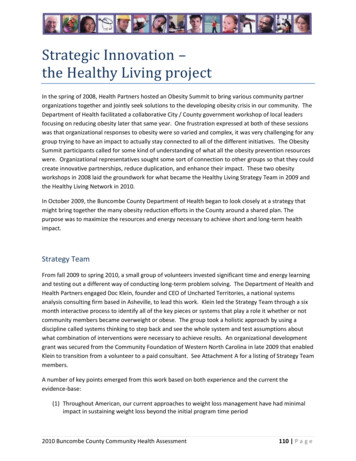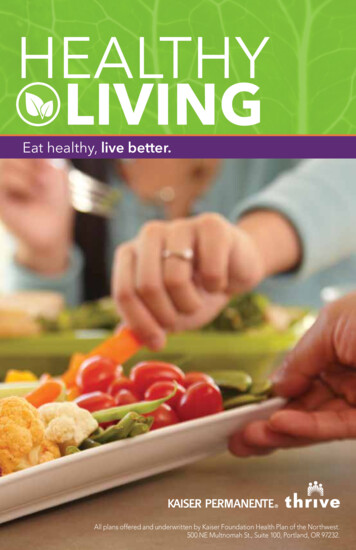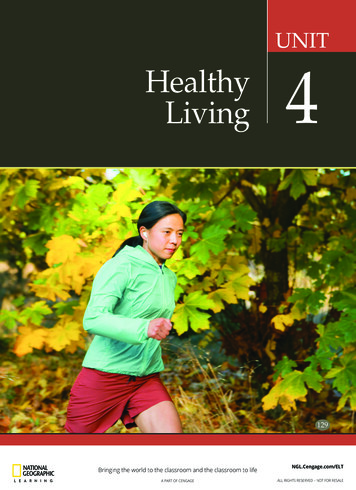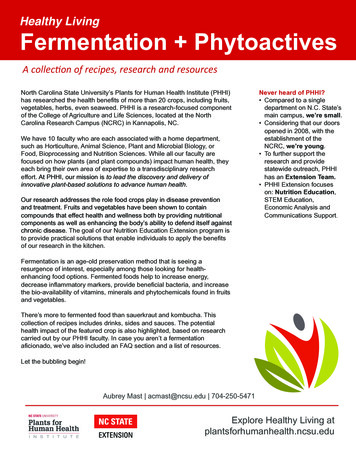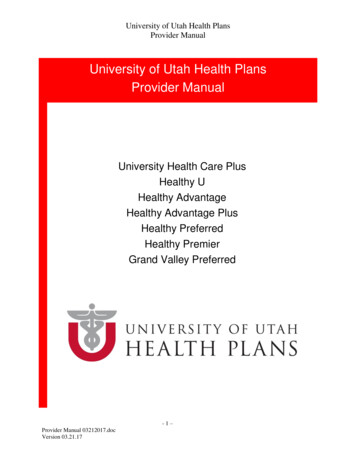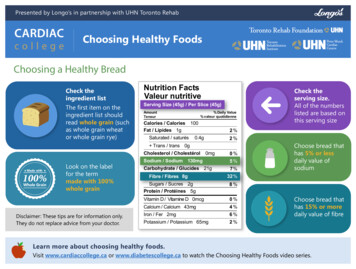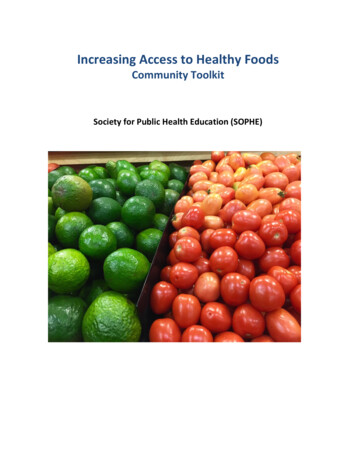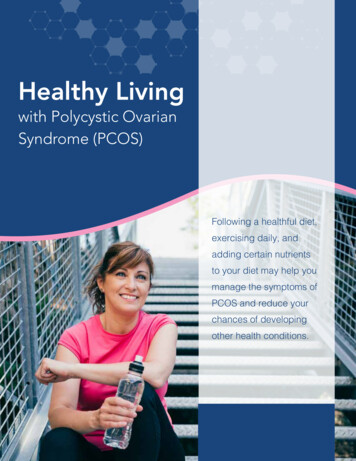
Transcription
Healthy Livingwith Polycystic OvarianSyndrome (PCOS)Following a healthful diet,exercising daily, andadding certain nutrientsto your diet may help youmanage the symptoms ofPCOS and reduce yourchances of developingother health conditions.
PCOS is an endocrine disorder affecting about7 million women and teenage girls in theUnited States.1 While there is no cure for PCOS,following a healthful diet, exercising daily andadding other important nutrients to your dietmay help you manage the symptoms of PCOSand reduce your chances of developing otherhealth conditions. In this eBook we will discuss:1Symptoms and health risks2The glycemic index3Meal planning4Healthy recipes5Exercise6Important nutrients
1SYMPTOMS ANDOTHER HEALTH RISKSPCOS symptoms can be different from woman towoman. Some common signs and symptoms include: Irregular or no menstrual periods Higher levels of the male hormone testosterone,which can cause facial hair growth and acne Polycystic ovaries (many small cysts on the ovaries) Insulin resistance Weight gain or having a hard time losing weightWhat is MetabolicSyndrome?Metabolic syndrome is a group of riskfactors including insulin resistance, high fatlevels in the blood, obesity, and high bloodpressure. If you have at least three of thefollowing five measures, this means youhave metabolic syndrome:4 Waist measurement: 35 inches or more Blood pressure: 130/85 mmHg or higher Fasting blood sugar level: 100 mg/dLor higher Fasting HDL (high-density lipoprotein),sometimes called "good" cholesterol:PCOS has also been linked to a higher risk of diabetes,heart disease, high blood pressure, metabolicsyndrome, and certain cancers. PCOS is also a commoncause of infertility.2Insulin ResistanceInsulin is a hormone that allows our cells to use glucose(sugar) to produce energy. When insulin resistanceoccurs, cells lose their ability to use insulin normally.This causes the body to produce extra insulin. The highblood level of insulin that results is related to many ofthe symptoms of PCOS. It may also result in impairedovulation, potentially causing fertility problems. Insulinresistance can also lead to diabetes and heart disease.3Page 3Healthy Living with Polycystic Ovarian Syndrome (PCOS)less than 50 mg/dL Fasting triglyceride level: 150 mg/dLor higher
2THE GLYCEMIC INDEXThe glycemic index (GI) is a measure of howmuch a food that contains carbohydrates canincrease blood sugar and insulin levels.Carbohydrates are the sugars, starches andfibers that are found naturally in fruits, grains(breads, cereals), vegetables and milk products.They are an essential part of a healthy diet.When you eat any type of carbohydrate, yourdigestive system breaks it down into simplesugars that enter the bloodstream. ChoosingImportance ofWeight ControlAchieving and maintaining a healthyweight is important. Weighing toomuch is associated with increasedinsulin resistance. Losing weight canbe a struggle though, especially forwomen with PCOS.Work with a registered dietitian ornutritionist who specializes in PCOSto determine a healthy weight foryou, and develop a personalizedplan to help you reach your goal.foods that have a low-GI can result in a slowerrise in blood sugar and insulin levels.Studies have shown that women with PCOSwho ate more low-GI foods had better insulinsensitivity and more regular menstrual cyclesthan women who did not follow a low-GI mealplan.5When planning meals, it is important to includelow-GI foods but also to look at the overallglycemic load (GL) of a meal to avoid suddenspikes in blood sugar. This can help manageinsulin resistance. 6What is GL?Each food has a unique effect on blood sugar.GL considers both the number of carbohydratesin a specific food and the GI of the food. Thismeasurement gives you a better estimate of theeffect a food has on your blood sugar level.Page 4Healthy Living with Polycystic Ovarian Syndrome (PCOS)“Moderate weight loss (atleast 5% of total bodyweight), has been shownto improve insulin andtestosterone levels andnormalize menstrual cyclesin women with PCOS.7For example, if you weigh150 pounds, losing just 8pounds can be helpful.”
3MEAL PLANNINGFollowing a low-glycemic meal plan can helpmanage symptoms of PCOS. Here are some tips forplanning low-glycemic meals and snacks.Low-GI RecipeEdamame Avocado SaladThis side dish has low-GI foods plus9 grams of protein and 5 grams offiber per serving, which can helpkeep your blood sugar level stable.Select lower-glycemic carbohydrate-rich foods inmoderation. Choose brown rice instead of white,a sweet potato over white potatoes, and if having aroll with dinner choose a whole grain one.Combine these carbohydrate-rich foods alongwith other foods that contain protein and fat,such as fish, eggs or chicken cooked in a healthy fatsuch as olive oil.Add vegetables to complete your meal.Adding vegetables such as carrots, broccoli,cauliflower, celery, tomatoes and zucchini to yourmeal will provide you a balance of foods to helpkeep your blood sugar and insulin levels in goodcontrol.Choose low-GI foods, such as:Dried beans, berries, 100% whole-grain breads,steel-cut oatmeal, quinoa, and vegetables suchas greens (kale, spinach, collards), broccoli,mushrooms, tomatoes and peppers.Eat these high-GI foods less often:Cookies, cakes, white rice, cornflakes, saltinecrackers, candy, sweet drinks and boiled potatoes.Page 5Healthy Living with Polycystic Ovarian Syndrome (PCOS)Preparation Time: 7 minutesCooking Time: noneServings: 4 2 teaspoons unseasoned ricevinegar 1 tablespoon olive oil 2 cups cherry tomatoes, halved 1 cup fresh or frozen, thawed,edamame 1 avocado, peeled and chopped ¼ teaspoon salt1. Whisk together the vinegarand oil.2. Toss the tomatoes, edamame andavocado with the dressing,sprinkle with salt.
4Turkey Bacon Wrap with Cheddarand Sliced PearHEALTHY RECIPESIn addition to the recipe on the previous page, thesetwo recipes balance carbohydrate-rich foods with leanproteins and healthy fats. Incorporate these types ofrecipes to jump start your healthy low-glycemic mealThis versatile meal is packed with31 grams of protein. It can be eatenfor breakfast, lunch or dinner. Forvariety, experiment with addingarugula or sliced tomatoes.plan.Chocolate Mousse RecipeThis simple dessert is sohealthy you can enjoy aserving every day. It has11 grams of protein and thecocoa has polyphenols whichcan help protect your heart.Preparation Time: 4 minutesCooking Time: noneServings: 2 One 7-ounce containerplain 2% Greek yogurt 2 ½ tablespoonsunsweetened cocoapowder 2 teaspoons granulatedStevia ½ teaspoon vanilla extract 1 tablespoon skim milk1. Whisk together allingredients.2. Divide into two bowlsand keep chilled untilready to serve.Page 6Healthy Living with Polycystic Ovarian Syndrome (PCOS)Preparation Time: 10 minutesCooking Time: 7 minutesServings: 1 Three slices turkey bacon One whole grain wrap One ounce cheddar cheese One pear with skin, thinly sliced1. Cook turkey bacon according topackage directions.2. Fill wrap with cheese and heat inmicrowave for 15 seconds to meltcheese.3. Add bacon and sliced pear andfold up wrap.
5EXERCISEExercising regularly is very important to helpmanage PCOS symptoms. Exercise helps your cellsuse insulin more efficiently and ensure your bodydoesn’t have too much insulin.8High-intensity interval training (HIIT)Research has found that a type of cardio workoutcalled high-intensity interval training (HIIT) can helpreduce insulin resistance, improve HDL (“good”cholesterol) levels, and lower body fat in womenwith PCOS.9HIIT workouts alternate between intervals ofchallenging, intense exercise and easier, lowintensity exercise. Each interval may be one, two, oreven up to eight minutes long. The workout usuallyincludes a short warm up and cool down, and lastsat least 30 minutes.Vigorous ExerciseAnother study showed that vigorous exerciseimproved insulin resistance and lowered the riskof metabolic syndrome in women with PCOS.This study found that for every hour of vigorousexercise per week, a woman with PCOS couldreduce her risk of getting metabolic syndrome by22%.10 Vigorous exercise includes activities such asrunning, bicycling fast and playing team sports suchas soccer or basketball.As with any exercise routine, remember to speakwith your healthcare team before beginning anexercise regimen.Page 7Healthy Living with Polycystic Ovarian Syndrome (PCOS)Getting Startedwith ExerciseIf you are just starting to exercise,remember any increase inmovement each day is good. Startslowly. You can work up to moreintense exercise as your fitness levelimproves.Here are some easy ways to getstarted: Go for a walk. Ask a friend to gowith you for motivation. Check out exercise programs atyour local community center orgym to see if there are any thatinterest you, and then try a classfor the activities you find exciting. Put exercise days and times in yourschedule to help ensure that youfollow through. Choose exercises that you like;you’ll be more likely to keepdoing them!As you become more comfortablewith exercising on a regular basisand your fitness level improves, youmay want to increase the intensity ofyour workouts.
4 IMPORTANT NUTRIENTSIn addition to eating a healthful diet and daily exercise, there is research to suggest that certain nutrientsmay also be helpful.NUTRIENTDOSAGEBENEFITSTwo forms of inositol have shown benefit for women with PCOS: MI and DCI. These inositolsnaturally occur in the body in a ratio of 40 (MI) to 1 (DCI).11InositolA nutrient found in fruits, beans,grains, and nuts and is alsomade by the body.2,000 mg ofmyo-inositol (MI)plus 50 mg ofd-chiro inositol (DCI),taken twice a dayOmega-3 Fish OilFatty acids found in fish such assalmon, herring, sardines, tuna,trout, and mackerel.2,000-3,000 mgOmega-3 fish oil may reduce depression, improve testosterone levels and regulate menstrualcycles.15-16 Consider an omega-3 fish oil supplement, especially if you do not eat fatty fish at leasttwice a week.Vitamin B12A water-soluble vitamin foundin animal products (fish, poultry,meat, eggs, and milk).VariesResearch has shown that long-term use of metformin decreases levels of vitamin B12 in the body.17Vitamin D3A fat-soluble vitamin producedin our skin after being in thesun. Small amounts are found insome foods.2,000-4,000 IUVitamin D may improve total testosterone levels in women with PCOS. 15,18,19 Ask your healthcareprovider to check your vitamin D blood level to determine how much vitamin D you need.CoEnzyme Q10 (CoQ10)A naturally- occurringantioxidant produced in thebody and found in virtuallyall cells. CoQ10 is essential forcellular energy production.100-200 mgCoQ10 may increase ovulation and pregnancy rates in women with PCOS going through fertilitytreatment.20 Also CoQ10 has been found to improve blood sugar and insulin levels, and totalcholesterol and LDL (“bad cholesterol”) levels.21MelatoninA hormone secreted by thepineal gland, which helpsregulate sleep and alsofunctions as an antioxidant inthe body.2-3 mgStudies show that taking a combination of these two forms is more helpful than taking either formalone. Inositols help decrease insulin resistance, improve testosterone levels, support healthyblood lipids, regulate menstrual cycles, and promote ovulation.12-14A deficiency of vitamin B12 can cause permanent neurological and nerve damage as well as moodchanges and decreased energy. If you are taking metformin ask your healthcare provider to checkyour vitamin B12 level to determine if taking B12 is right for you.Women with PCOS have low levels of melatonin in follicular fluid, which may decrease fertility.Studies show that melatonin supplements reduce testosterone levels, increase follicle-stimulatinghormone (FSH) and improve menstrual regularity.22-24Page 8Healthy Living with Polycystic Ovarian Syndrome (PCOS)
REFERENCES:1. PCOS Foundation. What is PCOS? Available at: http://www.pcosfoundation.org/WHY THERALOGIX?PCOS-Education-trifold.pdf. Accessed: August 17, 2018.2. Costello et al. Aust N Z J Obstet Gynaecol. 2012; 52(4):400-3.3. Marshall et al. Fertil Steril. 2013; 97(1): 18-22.4. Mahalingaiah and Diamanti-Kandarakis. Expert Opin Ther Targets.2015;19(11):1561-74.5. Marsh et al. Am J Clin Nutr. 2010; 92:83-92.6. Everyday Health.com. Available at: utrition-basics/the-glycemic-load.aspx. Accessed 8/14/18.7. Faghfoori et al. Diabetes Metab Synd. 2017; 11 Suppl 1:S429-S432.8. Benham et al. Clin Obes. 2018; 8(4):275-284.9. Almenning et al. PLoS ONE. 2015; 10(9), e0138793.10. Greenwood et al. Fertil Steril. 2016; 105(2):486-93.11. Nordio and Proietti. Eur Rev Med Phamacol Sci. 2012; 16:575-81.12. Artini et al. Gynecol Endocrinol. 2013; 29(4):275-9.13. Benelli et al. Int J Endocrinol. 2016:3204083.14. Constantino et al. Eur Rev Med Phamacol Sci. 2009; 13:105-10.15. Jamilian et al. J Affect Disord. 2018; 238: 32-38.16. Nadjarzadeh et al. Iran J Reprod Med. 2013;11(8):665-72.17. Niafar et al. Intern Emerg Med. 2015; 10(1): 93-102.18. Azadi-Yazdi et al. Horm Metab Res. 2017; 49(3): 174-79.19. Jamilian et al. Nutrients. 2017; 9(12): 1280-92.20. El Refaeey et al. Reprod Biomed Online. 2014 Jul;29(1):119-24.21. Samimi et al. Clin Endocrinol (Oxf). 2017;86(4):560-566.22. Tagliaferri et al. Reprod Sci. 2018; 25(2): 269-75.23. Pacchiarotti et al. Gynecol Endocrinol. 2016; 32(1): 69-73.24. Jain et al. J Hum Reprod Sci. 2013; 6(4):253-8.Theralogix nutritional supplements are basedon the most current scientific evidence foroptimal health. All formulations are overseenby a Medical Advisory Board of physicians andscientists and contain only the highestquality nutrients.All Theralogix supplements are tested fordisintegration, content accuracy, and purity byNSF International. NSF is an independent,not-for-profit public health organization thatcertifies products and writes standards for food,water and consumer goods. NSF has beenprotecting worldwide public health, safetyand the environment for 65 years. Theralogixnutritional supplements are among the mosttrusted nutritional supplements available.Page 9Healthy Living with Polycystic Ovarian Syndrome (PCOS)
To learn more, visitwww.theralogix.comPage 10Healthy Living with Polycystic Ovarian Syndrome (PCOS)
women with PCOS. Work with a registered dietitian or nutritionist who specializes in PCOS to determine a healthy weight for you, and develop a personalized plan to help you reach your goal. Importance of 2 Weight Control Moderate weight loss (at “ least 5% of total body weight), has
